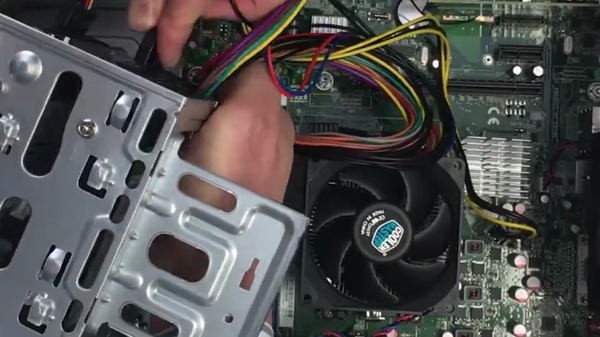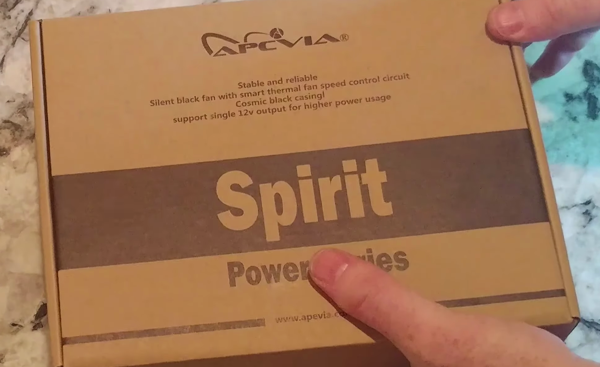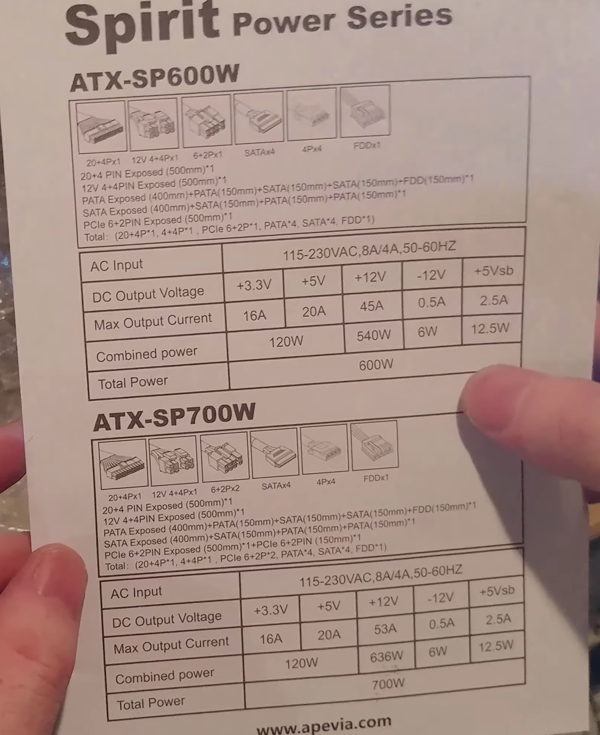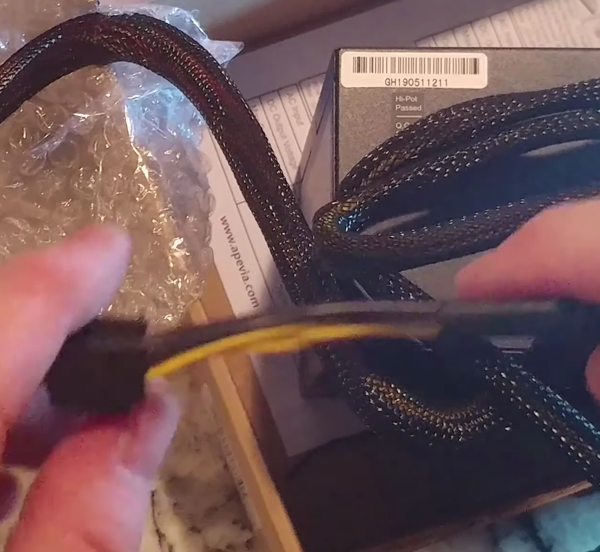Note: As an Amazon Associate I earn from qualifying purchases.
Good power supply: Trying out the Apevia ATX-SP700 Spirit ATX (2024)
Introduction
I recently had the chance to put the Apevia 700W Spirit ATX Gaming Power Supply to the test in several PC builds. It’s designed to support a wide range of systems and I wanted to see if it truly delivers on its promises. With its black sandblasted casing and comprehensive connector set, it looks like a promising addition to mid-range gaming and business computers. More on my thoughts below.
Specifications
| Property | Value | Property | Value |
|---|---|---|---|
| Model Name | spirit | Brand | Apevia |
| Compatible Devices | Personal Computer | Connector Type | atx, floppy, pci, sata |
| Output Wattage | 700 Watts | Form Factor | ATX |
| Wattage | 700 watts | Cooling Method | Air |
| Item Dimensions LxWxH | 5.9 x 6.3 x 3.4 inches | Item Weight | 3.8 Pounds |
Photos
Click on photos to enlarge them:
Prices
Check prices of the Apevia Spirit ATX-SP700 Power Supply on:
Power Supply Overview
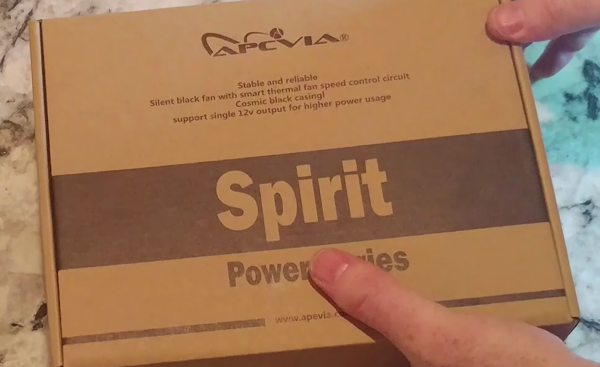
Assembling a computer requires a reliable power supply unit (PSU). I recently assessed the Apevia 700W Spirit ATX Gaming Power Supply due to its robust design and impressive specifications. The PSU’s black sandblasted casing provides both aesthetics and durability. This PSU accommodates Dual/Quad/Multi-core CPUs and features a single 12V rail, essential for consistent power delivery during heavy workloads.
I carefully examine Technical specifications.
Connectors: It offers a variety of connectors, including a 20/24pin Main Power connector, a 4+4pin 12V, PCI 6+2pin connectors, and several for SATA and peripheral devices. There’s even one for a Floppy, although that’s becoming a rarity in modern builds.
Apevia’s PSU is equipped with an auto-thermally controlled 120mm black fan for efficient temperature regulation. This fan ensures effective cooling by automatically adjusting its speed in response to changing temperatures.
This device is equipped with a range of safety features including Short-Circuit, Over-Current, Over-Voltage, Surge, Under-Voltage, and most importantly, Over-Temperature Protections. These protective mechanisms safeguard the device against potential damages caused by various electrical anomalies, ensuring optimal functionality and prolonging its lifespan.
One aspect that can be a little confusing is the provision of connectors. For instance, the 8pin CPU connector is actually a 4+4 pin connector to support different motherboard requirements. Similarly, there’s a 6+2pin PCI-E GPU connector for various graphics cards. These are flexible but require a certain level of knowledge to manipulate properly.
Now, considering this PSU for a build, I have to highlight the strengths and the limitations:
Pros:
Versatile connector options
Stable power for mid-range systems
Single 12V rail for consistent performance
The device includes safety features that protect it.
Cons:
The 120mm fan may be louder than you anticipate.
The connector system may be confusing for new users.
Thumb screws on some aesthetics might not please everyone.
Despite these drawbacks, I’ve had a positive experience with the Apevia 700W for my mid-range gaming and business builds. It delivers consistent performance without overheating. Its longevity in the market is impressive.
However, it’s important to note that the “auto-thermal” regulation in this product doesn’t live up to the quiet operation I expected. For budget setups, it could be a worthwhile investment. Yet, for expensive, high-end builds, I wouldn’t recommend it. Despite its drawbacks, at the given price point, it’s a reasonable option due to its sufficient power and various connectors.
Performance and Compatibility

When discussing power supplies, the Apevia ATX-SP700 delivers effectively with its 700 watts of power, sufficient for most mid-range gaming and business systems. Here’s a concise technical overview:
Support for Multi-core CPUs: Yes.
12V Single Output: Ideal for devices with greater power requirements.
Connectors Galore: Main power, CPU, PCIe, SATA, and even the outdated floppy.
An Auto-Thermally Controlled Fan, specifically a 120mm model, is integrated into our product for efficient cooling purposes. This fan automatically adjusts its speed based on the temperature, ensuring optimal performance and prolonging the lifespan of the component it is cooling.
Protections: Comprehensive electrical mishap coverage is provided.
In usage, the Apevia ATX-SP700 power supply works well for daily tasks. I’ve successfully run it with a NVIDIA 1660 Super graphics card, and distributed computing projects run smoothly without interruption, demonstrating its stability. The connectors, including CPU and PCIe ones, are adaptable and can split to meet various motherboard needs. This is a valuable feature that becomes apparent during the build process when you discover your motherboard has different requirements.
On the downside, the fan can produce noticeable noise. While it’s not as loud as a jet engine, those who prefer quiet computer setups may find it bothersome. Additionally, this model lacks a second EPS connector, which could be a limitation for users setting up dual CPUs without using adapters.
The added flexibility of this item is complemented by its tidy cabling design, which not only simplifies organization within the case but also considerately addresses the item weight. Weighing in at 3.8 pounds, this factor is essential to keep in mind when evaluating both the case size and the weight of the item itself.
I won’t avoid acknowledging that working with Apevia comes with some uncertainty regarding quality. Their past issues with Dead On Arrival units remain a concern. However, my experience using their products across multiple builds without any initial failures or overheating concerns suggests that they may have enhanced their quality control.
If you’re considering purchasing the Apevia ATX-SP700 power supply, evaluate its cost-effectiveness against potential risks. The price is reasonable, but it’s not a top-of-the-line model. I hope for long-term use, similar to an earlier Apevia power supply that lasted ten years. However, if it fails prematurely, I’ll reconsider my positive outlook. Despite this, the power supply currently delivers adequate performance for medium-spec builds at an affordable price.
Customer Support Experience

When assembling a PC, choosing the right power supply is essential. I’ve encountered varying experiences, especially with Apevia’s ATX-SP700. Although there have been challenges, there were also positive aspects worth mentioning. Here’s my account of customer support from Apevia:
Satisfactory Response Times: Responding to inquiries or issues in a timely manner can make all the difference, and I’ve found Apevia’s responsiveness to be decent.
Standard Support: They provide product troubleshooting and handle warranty claims.
Room for Improvement: The support process can be lengthy and complicated, presenting significant room for improvement when a prompt replacement is necessary.
In terms of customer support, my experience with Apevia has been inconsistent. While they do provide basic assistance, dealing with a faulty item was a lengthy process. My initial encounter involved a power supply issue that required more than a week’s wait for resolution. This delay can be disheartening, particularly when constructing a PC.
One could argue that a lengthy support process is the price for an affordable product. However, if a component like a power supply fails to perform effectively, it can put the entire system at risk. Dealing with local alternatives due to long wait times is an issue manufacturers should address. A more responsive and customer-friendly support system would be a noteworthy improvement and could significantly boost the overall brand experience.
Speaking of the issue I encountered with a malfunctioning unit, I had to request a replacement from Apevia. Initially, they were hesitant to provide one. However, after my persistence, they agreed to send a new unit but asked for the faulty one in return.
To sum up my experience with Apevia’s customer support:
Pros:
I can easily contact support when needed.
Provide a standard warranty and assistance for troubleshooting issues.
Cons:
Response and replacement times take too long.
Initially, there was reluctance to address faulty units.
From what I’ve learned, experiences with Apevia’s customer support show considerable variation. The support system exists, but resolving issues effectively is less consistent. Considering this when deciding on Apevia is advisable.
Longevity and Value

When considering a PC power supply or an upgrade, the Apevia ATX-SP700 offers a good balance between affordability and performance. Though opinions on its longevity and value differ, the overall consensus is positive when taking its price point into account.
Here’s a simplified version:
Pros:
Affordable option for budget-focused projects.
This power source offers a high wattage of 700W, suitable for various configurations.
The device operates quietly with a thermally controlled fan.
This feature ensures power stability.
Cons:
Some units have issues with durability, resulting in early failures or defects upon arrival.
The support experience can be unsatisfying, making it challenging to resolve issues promptly.
This model is less efficient than modern, more expensive ones.
The fan may operate at maximum speed even when there’s little workload, potentially causing noise concerns.
I’ve found the heavy-duty protections integrated in this model to be particularly effective in my projects. The robust safety features, including over-current, over-voltage, and over-temperature protection, have proven valuable additions given that my builds aren’t solely for personal use but also shared with others. These heavy-duty protections provide an extra layer of security and peace of mind, ensuring the safety of both the system and those using it. However, it may not be the optimal choice for high-end systems or those requiring peak efficiency and unyielding reliability.
While I appreciate the quiet operation and appearance of the 120mm black fan, I’m aware that it might become louder over time. My past encounters with customer support make me suggest keeping the original packaging on hand in case a return is needed.
It’s commendable that Apevia has kept the Spirit power supply line affordable and in use for almost a decade. The ATX-SP700, though not the most advanced or feature-rich PSU, shows Apevia’s dedication to meeting customers’ needs at an economical price.
In considering the costs and benefits, the affordable price-to-performance ratio is noteworthy. A $36 investment for a power supply with long-term usage potential is an acceptable risk for my less important projects.
Whether the Apevia ATX-SP700 power supply suits your needs depends on your specific requirements. For smaller to mid-range PC builds or as a temporary solution, it provides good value. However, if you demand ultimate stability and top-notch performance, it may be wise to look into more expensive power supplies instead. Remember, striking a balance between cost and quality is essential when purchasing PC components. The ATX-SP700 fits well within the budget-friendly category.
